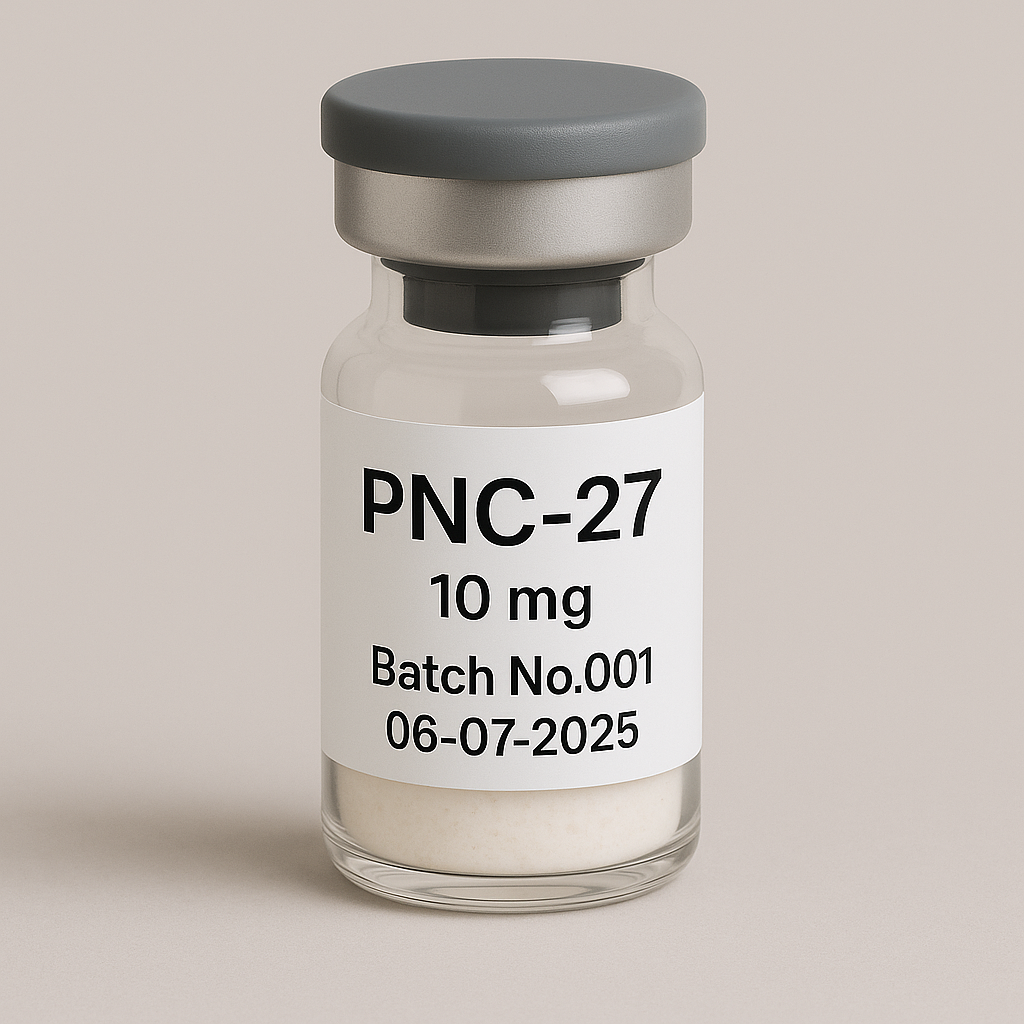
PNC-27 10mg vial
Afhalen is op dit moment niet beschikbaar
NOT FOR HUMAN CONSUMPTION
PNC-27 is a 27-mer chimeric peptide in which the p53 HDM-2–binding motif (residues 12-26) is covalently fused to a penetratin-derived “membrane-residency peptide” (MRP) that drives lipid-bilayer insertion. The construct, together with the close analogue PNC-28, was first disclosed in the international patent WO2009070650A1 and assigned to the SUNY Downstate inventors (sub-licensing now held by Oncolyze, Inc.).
2 Molecular Mechanism — From Target Recognition to “Poptosis”
| Step | Molecular event | Experimental evidence |
|---|---|---|
| Target selection | Many malignant cells aberrantly traffic HDM-2 (MDM2) to their outer membrane leaflet; normal cells rarely do so. | Flow-cytometry and immuno-EM surveys in >30 cancer lines and primary AML blasts; negligible signal in matched normal tissues. |
| Anchoring | The p53 segment of PNC-27 docks into the canonical HDM-2 pocket exactly as wild-type p53. | NMR and docking data plus competitive-binding assays. |
| Membrane insertion & oligomerisation | The MRP penetrates the bilayer; HDM-2/PNC-27 complexes self-assemble. | Immuno-EM visualises ring-shaped oligomers. |
| Pore formation (4–6 nm) | Transmembrane pores produce uncontrolled ion flux. | TEM of treated cancer cells; no pores in treated fibroblasts. |
| Necrotic cell death — “poptosis” | Rapid LDH release, mitochondrial collapse, and irreversible necrosis independent of p53 signalling. | Time-course cytotoxicity and biomarker panels. |
Result: PNC-27 lyses tumour cells in minutes while sparing normal cells that lack surface HDM-2.
3 Pre-clinical Efficacy Dossier
| Experimental context | Dose / conditions | Outcome |
|---|---|---|
| Solid-tumour cell lines (breast, pancreatic, melanoma, lung, SK-OV-3 ovarian) | 1–5 µM (2-h exposure) | 100 % kill within ≤3 h; paired fibroblasts/endothelium unaffected. |
| p53-null leukaemia (K562) | 0.5–2 µM | Complete necrosis despite absent p53. |
| Primary ovarian-tumour explants | 1–5 µM ex vivo | Tumour epithelium lysed; adjacent normal tissue spared. |
| Ovarian xenograft (SK-OV-3, nude mouse) | 2 mg kg⁻¹ day⁻¹ IP × 28 d | Significant bioluminescence suppression; histology shows reduced viable tumour. |
| Paclitaxel combination | Paclitaxel + PNC-27 (above) | Bliss-index < 1; PNC-27 eradicates paclitaxel-resistant residual cells. |
4 Selectivity and Toxicology
-
Maximum tolerated dose (mouse): 2 mg day⁻¹ IP for 28 d with no weight loss, behavioural changes or gross-organ toxicity.
-
Normal-cell window: Fibroblasts, endothelial cells, PBMCs and marrow progenitors withstand ≥10× tumour-lytic concentrations.
-
Open questions: No GLP repeat-dose, reproductive or large-animal studies; immunogenicity is uncharacterised; systemic inflammatory sequelae of extensive tumour necrosis have not been modelled.
5 Pharmaceutical and Manufacturing Issues
| Challenge | Current status | Consequence |
|---|---|---|
| Proteolytic stability | Serum half-life predicted <10 min; no PEGylated or liposomal formulations yet published. | May require continuous infusion or nano-carrier delivery. |
| Sterility & GMP | FDA found Variovorax paradoxus (Jan 2017) and Ralstonia insidiosa (Mar 2017) in retail “PNC-27 inhalation” vials. | Demonstrates urgent need for GMP production and validated endotoxin testing. |
| Scale-up & IP freedom | Core sequence protected under WO2009070650A1 until at least 2029 in major jurisdictions. | Commercial developers must license or wait for expiry. |
6 Regulatory and Legal Landscape
-
FDA status: No INDs or authorised clinical trials; 2017 FDA alert classifies PNC-27 as an unapproved drug and highlights contamination risks.
-
Criminal enforcement: U.S. v. Patrick Bishop (2021) – guilty plea for manufacturing and interstate sale of misbranded PNC-27 products made in a domestic kitchen/warehouse.j
-
Marketing abuses: Multiple websites still purport “overseas clinical success” but provide no registry numbers or peer-reviewed data.
7 Critical Knowledge Gaps Blocking Translation
-
Human pharmacokinetics and metabolism are wholly undefined.
-
Immunogenicity of repeated dosing and risk of neutralising antibodies remain unknown.
-
HDM-2 expression plasticity under stress (infection, hypoxia, chemotherapy) may narrow the therapeutic window in vivo.
-
Resistance evolution – long-term exposure might select HDM-2-negative tumour clones; no studies yet.
-
Companion diagnostics to stratify patients by membrane HDM-2 expression are lacking.
8 Roadmap to First-in-Human Development
-
GMP manufacture with validated identity, purity, sterility and endotoxin profiles to resolve past quality failures.
-
GLP toxicology in rodents and a non-rodent (e.g., canine) model, including repeat-dose and safety-pharmacology endpoints.
-
Phase I trial design: dose-escalation in refractory solid tumours or AML with confirmed high membrane HDM-2; intensive PK and cytokine monitoring.
-
Imaging or IHC biomarker for membrane HDM-2 to guide enrolment and pharmacodynamics.
-
Combination cohorts with paclitaxel or platinum agents to validate pre-clinical synergy.
9 Balanced Assessment
PNC-27 delivers a mechanistically elegant, membrane-targeted oncolytic strategy that bypasses p53 status and chemosensitivity. Laboratory evidence demonstrates rapid, selective destruction of a wide spectrum of cancer cells, including chemo-resistant populations, with a large in-vitro therapeutic index. Conversely, the peptide has no human pharmacology, no GLP toxicology, and a documented history of contaminated grey-market products and regulatory enforcement. Until rigorous manufacturing and clinical studies are completed, PNC-27 remains an intriguing but unvalidated research lead rather than a viable therapeutic.
References
-
Yefet L et al. PNC-27, a chimeric p53-penetratin peptide binds to HDM-2, induces selective membrane-pore formation and cancer-cell lysis. Biomedicines 2022;10:945.
-
Annunziata CM et al. Synergy between paclitaxel and anti-cancer peptide PNC-27 in the treatment of ovarian cancer. Ann Clin Lab Sci 2017;47:271-9.
-
U.S. FDA. FDA warns cancer patients not to use PNC-27 products for treatment. Safety Communication, 10 Jan 2017 (updated 27 Mar 2017).
-
U.S. Department of Justice. Birmingham man pleads guilty to conspiracy for making unapproved drug products in his kitchen and warehouse. Press release, 21 Jan 2021.
-
Hall DJ et al. Small-molecule cancer treatments that cause pore formation leading to necrosis of cancer cells.WO2009070650A1 (international patent).
-
Li X et al. Targeting cell-membrane HDM2: a novel therapeutic approach for acute myeloid leukaemia. Cell Death Dis 2021;12:298.
-
Sarraf G et al. PNC-27 adopts an HDM-2-binding conformation and induces selective membranolysis of cancer cells. Proc Natl Acad Sci USA 2009;106:20352-7.

